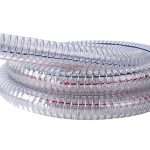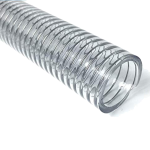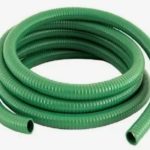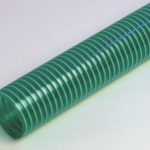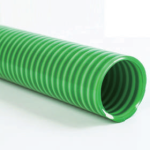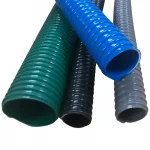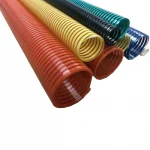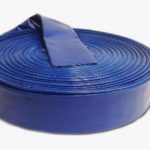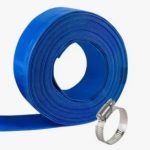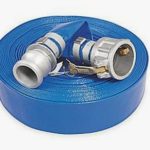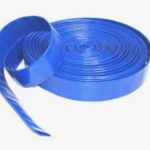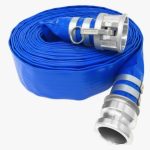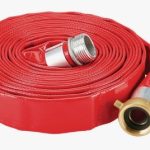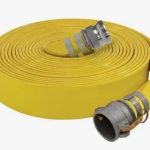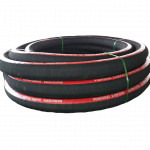Although both suction hose and discharge hose are used for fluid transfer, they have very different purposes. Suction hose is used to suck fluid from the fluid source, while discharge hose is used to discharge the fluid to the destination. The main difference between suction hoses and discharge hoses is that the suction hose will not collapse under vacuum pressure because the suction hose reinforcement layer has steel wire as support.

Mainly because of their different hose structures, suction and discharge hoses are reinforced with multiple layers of fabric cords and wrapped with 1 or 2 layers of steel wire to improve bending resistance, strengthen the hose structure and extend service life.
Therefore, suction and discharge hoses can be used in positive and negative pressure working environments, and are used to suck and discharge industrial water and neutral liquids at room temperature.
It is widely used in mines, factories, agriculture, civil engineering and construction projects. In addition, it can also be used as a water delivery hose for agricultural irrigation.
Understanding the difference between these two hoses can help ensure that the right equipment is used to complete the task, prevent damage, reduce downtime and optimize performance.
Suction Hose
What is a Suction Hose?
A suction hose is a hose specifically designed to draw or "draw" fluid from a water source such as a tank, reservoir, or natural body of water. It operates under negative pressure, meaning it relies on external atmospheric pressure to push the fluid into the hose while simultaneously creating a vacuum inside the hose. The main function of a suction hose is to facilitate the flow of fluid from its source to a pump or treatment system. Suction hoses are often used in systems that require the transfer of fluids over varying distances and heights.

Suction Hose Construction and Design Features
Material Composition (e.g., rubber, PVC)
Suction hoses are typically made of durable materials such as rubber or PVC and are designed to withstand negative pressure without collapsing. Rubber is favored for its flexibility and abrasion resistance, while PVC is a lightweight and cost-effective alternative.
Reinforcement Layers
To prevent the hose from collapsing under vacuum pressure, suction hoses are reinforced with multiple layers of spiral wire or synthetic yarn. Spiral wire reinforcement is especially common in heavy-duty suction hoses, which provides the necessary structural integrity to maintain the hose's shape even under significant negative pressure.
Flexibility and Durability Considerations
Flexibility is a key feature of suction hoses, allowing them to be easily manipulated and positioned in a variety of operating environments. Durability is equally important, especially in harsh environments where the hose may be exposed to abrasive materials, extreme temperatures, or harsh chemicals.
Suction Hose Application
Industrial, Agricultural and Residential Uses
Suction hoses are used in a wide variety of applications including industrial, agricultural and residential applications. Suction hoses are essential in processes where fluids need to be moved from a low level to a high level, or from a remote location to a central processing point.
Specific Examples
Pumping water from a well: In agricultural and residential settings, suction hoses are often used to pump water from a well, especially in areas without direct access to a municipal water supply.
Slurry Transfer: In industrial applications, suction hoses are used to transfer slurries (a mixture of solid particles suspended in a liquid), such as in mining operations or wastewater management systems. These hoses are designed to handle the abrasive nature of slurries while maintaining a steady flow rate.
Advantages and Disadvantages
Advantages
High Flexibility: Suction hoses are designed to be highly flexible, able to bend and go around obstacles without kinking. This flexibility is critical for applications that require them to pass through tight spaces or around machinery.
Durability in Harsh Environments: Suction hoses are designed to withstand harsh environmental conditions, including chemical exposure, UV rays, and physical abrasion. This makes them suitable for indoor and outdoor use in harsh industrial environments.
Disadvantages
Weight: Suction hoses, especially those reinforced with spiral wire, are relatively heavy, making them more difficult to handle and transport than lighter hoses, such as discharge hoses.
Handling: The rigidity required to prevent collapse under vacuum pressure can make suction hoses less flexible than other types of hoses, which can create challenges in certain applications.
Discharge Hose
What is a Discharge Hose?
A discharge hose is a hose used to transfer and discharge fluids from a pump or other equipment to a designated discharge point. Unlike suction hoses, discharge hoses operate under positive pressure, pushing fluids through the hose to a predetermined location. The main function of a discharge hose is to suck, process or transfer fluids away from a pump or system. These hoses are essential in operations where fluids need to be transferred over long distances or stored to storage areas, drainage systems or irrigated fields.

Construction and Design Features
Material Composition (e.g., rubber, PVC)
Drain hoses are often made of materials such as rubber or PVC, similar to suction hoses, but are designed specifically to drain rather than suck in liquids. Rubber drain hoses are known for their durability and abrasion resistance, while PVC hoses are prized for their lightness and cost-effectiveness.
Lightweight Construction Compared to Suction Hoses
Drain hoses are typically lighter in construction than suction hoses. This is because they do not require the same degree of reinforcement to prevent collapse under vacuum pressure. The lighter weight makes them easier to handle, especially in applications where the hose needs to be moved or repositioned frequently.
Reinforcement Type and Pressure Rating
Drain hoses may still contain reinforcement, but its primary function is to withstand the positive pressure generated by the discharged fluid rather than to prevent it from collapsing. This reinforcement can be a braid or spiral synthetic fiber that provides the necessary strength to withstand varying degrees of pressure. The pressure rating of a discharge hose is a key factor in determining whether it is suitable for a particular application, especially in industrial environments where high pressures may be involved.
Discharge Hose Application
Industrial, Agricultural, and Residential Uses
Drain hoses are used in a wide variety of industries, from industrial, agricultural, to residential applications. They are essential for efficiently moving fluids from one location to another, especially when the fluid needs to be drained from the system after use.
Specific Examples
Basement Drainage: In residential settings, drain hoses are often used to drain water from basements or other low-lying areas that are susceptible to flooding. These hoses connect to sump pumps to move water from the house to a safer area.
Irrigation Fields: In agricultural applications, drain hoses are used to move water from pumps to irrigated fields, ensuring that crops receive the necessary moisture. The hose's flexibility and ease of movement make it ideal for covering large areas with varying terrain.
Discharge hose advantages and limitations
Advantages
Lightweight: Discharge hoses are lightweight and easier to handle, transport, and deploy, especially in situations where the hose needs to be repositioned frequently or transported over long distances.
Easy to maneuver: Because discharge hoses are less rigid than suction hoses, they have greater flexibility and can easily maneuver around obstacles and through tight spaces. This maneuverability is especially beneficial in complex or confined work environments.
Potential disadvantages
Less durability under certain conditions: Discharge hoses, especially those made from lighter materials like PVC, may not be as durable as suction hoses in certain situations. They are more susceptible to wear and tear, especially when exposed to abrasive materials or harsh environmental factors.
Lower pressure resistance: Although discharge hoses are designed to withstand positive pressure, they are generally less pressure resistant than suction hoses. This makes them less suitable for high-pressure applications and can cause hose failure if the pressure exceeds the hose's rating.
Differences Between Suction and Discharge Hoses
A. Function
Suction Hoses: Suction hoses are used to draw liquids from a source, such as a tank, well, or body of water. They operate under negative pressure, with the outside atmospheric pressure pushing the liquid into the hose, while the internal vacuum created by the pump draws the liquid upward.
Discharge Hoses: Discharge hoses, in contrast, are designed to push or discharge liquids from a pump or other device to a desired location, such as a drainage system, storage tank, or irrigation field. These hoses operate under positive pressure, meaning the pump forces the liquid through the hose to its destination.
B. Construction and Reinforcement
Suction Hoses: Suction hoses are typically made of durable materials such as rubber or PVC and require a sturdy reinforcement structure to prevent collapse under vacuum pressure. This reinforcement structure, which is usually a spiral steel wire or synthetic yarn, maintains the structural integrity of the hose even under large negative pressures.
Discharge Hoses: Discharge hoses are also made of materials such as rubber or PVC, but do not require the same reinforcement as suction hoses. They are lighter in construction, and the reinforcement (if any) is designed to withstand the positive pressure generated by the discharged fluid. This makes them more flexible and easier to handle.
Differences in Flexibility, Durability, and Collapse Resistance
Flexibility: Suction hoses are generally less flexible due to their structural reinforcements, which are designed to prevent collapse under vacuum conditions. Discharge hoses, on the other hand, are more flexible and easier to handle due to their less structural reinforcement, especially in applications that require frequent repositioning.
Durability: Suction hoses tend to be more durable, especially in harsh environments, as they must not only withstand internal vacuum pressures, but also external environmental factors. Discharge hoses, while still durable, may not be able to withstand the abrasive environments that suction hoses can.
Collapse Resistance: The main design difference is that suction hoses need to resist collapse under vacuum conditions. Discharge hoses do not face this challenge, so less emphasis is placed on structural rigidity.
C. Pressure Ratings and Tolerances
Suction Hoses: These hoses are designed to handle negative pressures. Their design ensures that even if the internal pressure drops below atmospheric pressure, the hose maintains structural integrity and prevents collapse.
Discharge Hoses: Discharge hoses are designed to withstand positive pressures, meaning they are able to withstand the forces generated when fluid passes through them. Their pressure resistance varies by material and construction, but they are generally not suitable for negative pressure, as this is not their intended use.
D. Application Suitability
Where Suction Hose is Suitable
Deep Pumping: Suction hoses are ideal when fluids need to be drawn from deep wells, storage tanks, or other sources below the pump level.
Handling Abrasives: Suction hoses are a better choice for industrial applications that convey abrasives due to their durability and resistance to collapse.
Use in Harsh Environments: Suction hoses are ideal for use in harsh environments where they may be exposed to rough handling, chemicals, or extreme temperatures, due to their rugged construction.
Ideal Situations for Discharge Hose
Fluid Drainage and Distribution: Discharge hoses are the best choice for applications where the primary need is to move fluids from the pump to a disposal or storage location (e.g., draining a flooded area or irrigating a field).
Need for Lightweight and Easy Maneuverability: Discharge hoses are more suitable due to their lighter weight and increased flexibility when the hose needs to be moved or positioned frequently.
Short Distance Transfer: For shorter fluid transfer distances, when high pressure is not a major concern, a discharge hose is often more convenient and cost-effective.
Choosing the Right Hose for Your Needs
A. Factors to Consider
Fluid Type: The nature of the fluid being conveyed is a key factor. For example, conveying chemicals, abrasive slurries, or potable water may require hoses made from special materials that are resistant to corrosion, abrasion, or contamination.
Temperature: Both fluid temperature and ambient temperature affect hose performance. High-temperature fluids may require hoses made from materials that can withstand heat without degradation, while cold environments may require hoses with increased flexibility to avoid cracking.
Environmental Conditions: Consider the environment in which the hose will be used, such as exposure to UV rays, chemicals, or rough handling. Hose material selection should be based on its ability to withstand these conditions without compromising its integrity.
Pressure Requirements and Flow Rates
Pressure Requirements: Evaluate the pressure requirements of the application, both suction and discharge. Suction hoses must be able to withstand negative pressure without collapsing, while discharge hoses must be able to withstand the positive pressure created by the discharge fluid. The hose should be rated for pressure in excess of the system's maximum working pressure.
Flow Rate: Flow rate, the amount of fluid that must be conveyed in a specific amount of time, affects the diameter and material of the hose. Higher flow rates may require a larger diameter hose or a hose with a smooth interior to reduce friction losses.
B. Application Scenarios
Examples of When to Choose a Suction Hose
Well Pumping: When pumping water from a well or underground reservoir, a suction hose is required because it is able to withstand the negative pressure required to lift the fluid from a lower level.
Industrial Slurry Transfer: The durability and reinforcement of the suction hose make it an ideal choice in industries where abrasive slurries or heavy fluids need to be moved from one point to another.
Vacuum Tank Applications: For vacuum tank applications that require suction of material under negative pressure, the suction hose is critical to ensure that the fluid is properly delivered and the hose does not collapse.
Examples of When to Choose a Drain Hose
Flood Exclusion: To extract water from flooded areas, a drain hose is used to drain the water out of the site. Drain hoses are flexible and lightweight, making them easy to deploy and operate in such situations.
Agricultural Irrigation: Drain hoses are ideal for agricultural irrigation where water needs to be delivered to large fields. They are lightweight, easy to operate, and can be quickly repositioned as needed.
Construction Site Drainage: On construction sites where excess water needs to be removed, drain hoses can effectively move water away from the site to a drainage area, ensuring the site remains dry and work can continue safely.
C. Custom Options
Custom hoses for special applications available
Custom lengths and diameters: Depending on your specific application needs, hoses can be ordered in custom lengths and diameters to ensure a perfect fit. This is especially useful for jobs where standard sizes may not meet the needs of large-scale operations.
Special materials and reinforcements: For applications that require special corrosion resistance, hoses can be customized with materials that are resistant to specific chemicals, high temperatures, or abrasion. Reinforcements can also be customized, such as adding extra layers or choosing different reinforcements to increase durability and pressure resistance.
Tips for choosing the right materials and reinforcements
Material selection: When customizing a hose, choose the material that best matches the fluid type and environmental conditions. For example, you can choose Nitrile (oil resistant) while EPDM (hot water and steam resistant) can be chosen.
Reinforcement considerations: Reinforcement is key to the hose's ability to withstand pressure and external forces. For applications that require high durability and collapse resistance, consider spiral wire reinforcement; for applications that require greater flexibility and lightness, consider fabric reinforcement.
Conclusion
Factors such as fluid type, operating pressure, temperature and environmental conditions can all affect the suitability of a suction or discharge hose. By thoroughly evaluating these needs, you can ensure that the hose you select not only meets the operational requirements, but also combines durability and efficiency. If you are unsure which hose is best for your application, consider consulting Topa, where we can provide customized recommendations based on your specific situation. In addition, you can also learn about the available product options, including customizable hoses, to better meet your specific operational needs.
FAQ
What is the main difference between a suction hose and a discharge hose?
Suction hoses are used to draw fluid into a system under negative pressure, while discharge hoses are used to draw fluid out of a system under positive pressure.
Can I use a discharge hose for suction?
No, discharge hoses are not designed to handle the negative pressure required for suction and may break if used this way.
What materials are suction and discharge hoses typically made of?
Both hoses are typically made of durable materials such as rubber or PVC, and suction hoses typically have additional reinforcement to prevent collapse.
How do I choose the right hose for my application?
Consider fluid type, pressure requirements, temperature, and environmental conditions. For suction, choose a reinforced hose; for discharge, choose a flexible hose suitable for the fluid being discharged.
Are there customizable options for suction and discharge hoses?
Yes, many suppliers offer custom lengths, diameters, and materials to meet specific application requirements.
What are common applications for suction and discharge hoses?
Suction hoses are commonly used for well pumps and slurry transfers, while discharge hoses are commonly used for agricultural drainage and irrigation.
About Sinopulse Hose Factory
Sinopulse hose factory is a supplier of industrial hose, rubber and hydraulic solutions for a variety of industrial markets. We offer custom assemblies as well as industry standard hose assemblies. Our markets include rental, construction, liquid waste disposal, agriculture, manufacturing and plant facilities, hydraulics, original equipment manufacturers (OEM), and environmental businesses.
Sinopulse has a dedicated line of reinforced suction and discharge hoses that feature a unique spiral design that is both functional and unique. Manufacturing in China means shorter lead times and more affordable prices, and you can be assured that we maintain the highest standards in materials, quality and production processes. We can help you choose the right suction and discharge hose for your specific project.
We hope you have found this guide useful. We offer a wide range of suction and discharge hoses for a wide range of industries and applications, making it easy for you to find the right product. Feel free to browse our product range, and if you have found what you are looking for, you can contact a member of our friendly sales team for a free quote.
For more information, please contact any of our offices or email us at sales@sinopulse.cn

